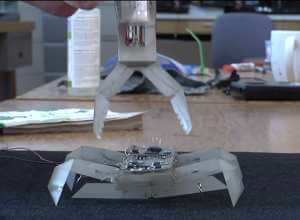On-Demand Robots From A 3D Printer

Share
We’ve seen 3D printers churn out toys, bone models, chocolate, even human tissue. Now scientists at MIT want to print robots. Not the cool, stainless steel types that your kids will want to play with, but programmable bots that can help out around the house or carry out life-saving reconnaissance in the wake of a disaster.
Even better, it’ll take less than 24 hours to print them out.
Right now building a robot takes years, requires hardware and software development, and is costly. The 3D printing group, MIT’s Computer Science and Artificial Intelligence Laboratory (CSAIL), wants to design a robot platform that is inexpensive, simple enough to be used to non-experts, but sophisticated enough to perform different specialized functions.
The plastic robotic backbone is what’s actually printed out. What form is printed out depends on the function the user chooses. Electronics and actuators are then attached to the printout. Wired has a short video of two prototypes the researchers have produced thus far: an insect-like crawler and a gripper. Something like the crawler could carry a camera or sensors into an area with a chemical spill or a place like the contaminated Fukushima Daiichi power plant. Or it could check to see if you have rats in your attic, if you’re not all that interested in checking yourself. The gripper could be used to help the elderly or handicapped people get a handle on household objects. Both robots cost $100 and took about 70 minutes to make.
https://c.brightcove.com/services/viewer/federated_f9
Yes, owning our own robots built to our own specifications will soon be a reality. Well, relatively soon. The project is part of a 5-year grant just awarded by the National Science Foundation, so you have until 2017 to decide on just what robot will be the most valuable to you.
Be Part of the Future
Sign up to receive top stories about groundbreaking technologies and visionary thinkers from SingularityHub.


The MIT group is teaming up with researchers at Harvard and Penn University on the project. Their group venture, entitled “An Expedition in Computing for Compiling Printable Programmable Machines,” was recently awarded a $10 million grant from the National Science Foundation. The next five years will be spent making the platform as user-friendly as possible so the average person can, not only design their own robot, but program it too. As Daniela Rus, the project leader at MIT, said in an MIT announcement: “We believe that it has the potential to transform manufacturing and to democratize access to robots.”
There is still a great deal of work to be done before their robot truly becomes democratized. The team is currently working on an API that would simplify the design process, algorithms that make it easy to control the robot, and a programming language that the average person can use. At the moment the robot comes pre-programmed to perform defined tasks, but ideally even a novice user would program it to perform more complex commands.
And once the greenhorn gets his programming legs, there’s the worry that he’ll break the robot’s. Rus explained that there are as yet no safety measures against bad commands that would result in a broken robot. In addition, the prototypes are not very durable. Toughening them up will be necessary if people are going to want to spend the time printing and programming them, even if it’s already incredibly quick and easy to begin with.
Normally the term household robots conjures up visions closer to Asimo than these little origami insects. But the tradeoff of performance for accessibility means more people will actually have robots in their houses. For many, these printable robots could do much to convert a curiosity into a passion.
[image credit: MIT]
[video credit: Wired]
images: printable robot
video: printable robot
Peter Murray was born in Boston in 1973. He earned a PhD in neuroscience at the University of Maryland, Baltimore studying gene expression in the neocortex. Following his dissertation work he spent three years as a post-doctoral fellow at the same university studying brain mechanisms of pain and motor control. He completed a collection of short stories in 2010 and has been writing for Singularity Hub since March 2011.
Related Articles

AI Companies Are Betting Billions on AI Scaling Laws. Will Their Wager Pay Off?

Are Animals and AI Conscious? Scientists Devise New Theories for How to Test This

Is the AI Bubble About to Burst? What to Watch for as the Markets Wobble
What we’re reading
